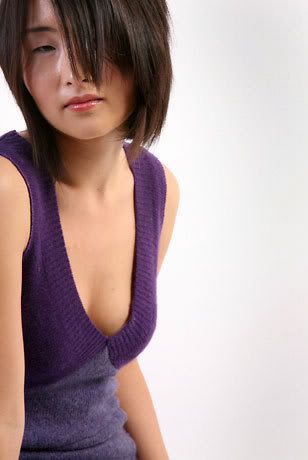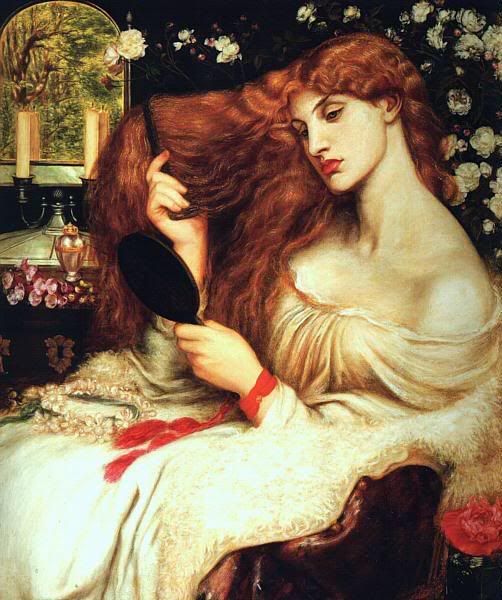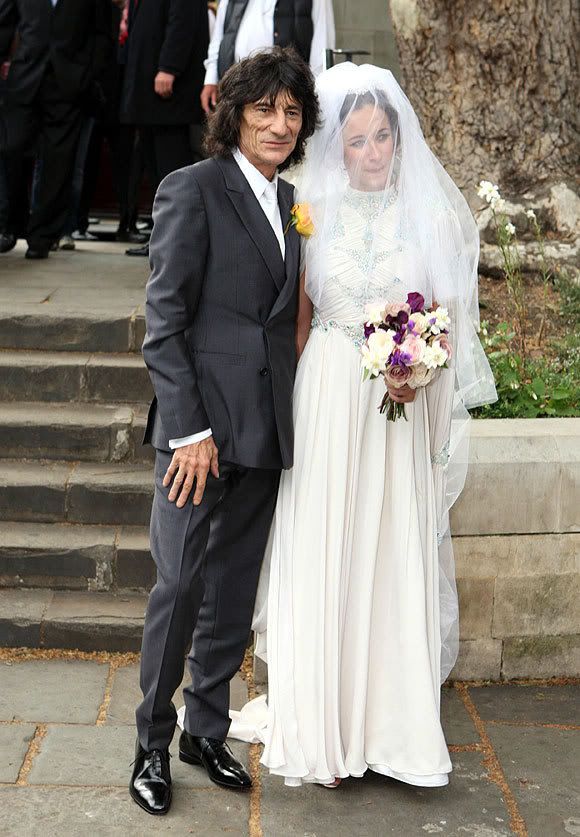
Leah Wood, daughter of Rolling Stones rocker Ronnie Wood, was married to TV Producer Jack McDonald last month at Southwark Cathedral. Her Pre-Raphaelite inspired gown was the toast of the affair. It featured a pleated bodice, intricate embroidery, draping sleeves and a juliet cap (I haven't seen one of those in a while!). Her bouquet also had an old fasioned feel, and was made of pale pink roses, irises and other more traditional flowers.
Afterwards the wedding party headed to the reception (which was held at Ronnie Wood's mansion in Surrey), which was based around the theme Shakespeare's A Midsummer Night's Dream. What a lovely idea!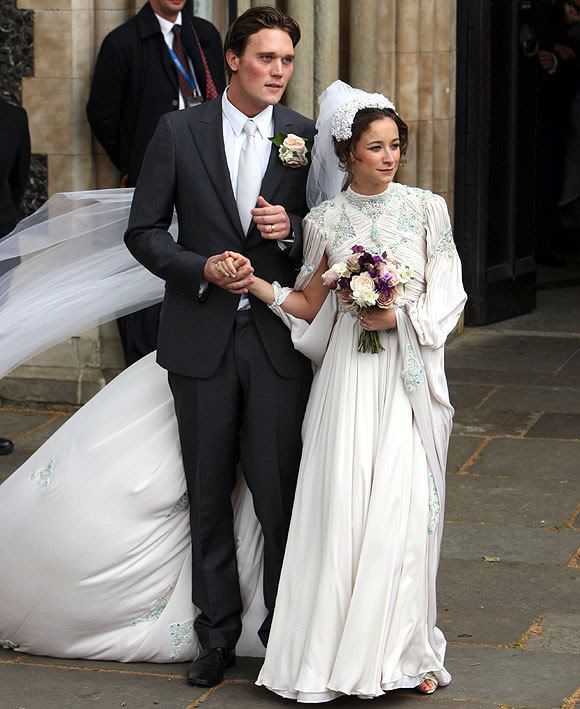
Wednesday, July 9, 2008
Rolling Stone's Daughter Marries in Pre-Raphaelite Inspired Wedding Gown
Posted by
Margaret
at
11:17 AM
3
comments
![]()
![]()
Labels: fashion
Monday, May 26, 2008
Deluxe: How Luxury Lost its Lustre

I'm forever moaning about the demise of luxury--true luxury--which to me means hand crafted products made by people who are passionate about their art. And so, when I saw Dana Thomas being interviewed on Canada's Fashion Television about her new book Deluxe: How Luxury Lost its Lustre, I knew I had to read it! I bought it for the trip home from Paris and finished it in one sitting.
In the book, Thomas takes her readers on a tour behind the scenes of the world's best-known luxury brands. In the process, she reveals that many of the brands we associate with luxury and quality are actually anything but. Thomas details how luxury manufacturers cut corners to fatten up their bottom line through techniques like using cheap thread (Prada), shortening the sleeves on their suits, manufacturing goods in third world countries and then tearing out the labels and replacing them with ones that read "made in Italy" (Valentino) and making the uppers of their shoes in one country and the bottoms in Italy so that their products can legally read "made in Italy"(Prada again).
While Deluxe is critical of cost-cutting measures like having goods made in China, Louis Vuitton Moet Hennessy (LVMH) mastermind Jean Arnault comes across as the villain of the book for his aggressive business tactics (he routinely engages in hostile takeovers of family-owned businesses) and his way of re-invisioning luxury as focused on branding, rather than quality.
Thomas is particularly harsh on Louis Vuitton, Valentino and Georgio Armani , although very few luxury brands escape her critique. The one brand that seems to escape relatively unscathed is Hermes: their products may be overpriced, but they have held fast to their commitment to creating quality handcrafted objets d'art.
Dana Thomas also explores the world of fake luxury goods. In a world where brands are more prized than true quality, fakes are inevitable. People want a piece of the image they feel wearing a certain brand creates. Unfortunately, there is a real price for buying fakes--money from the sale of counterfeit goods supports organized crime and terrorist organizations like FARC in Colombia. Moreover, conditions in the factories where these goods are produced are MUCH, MUCH worse than in legal factories--since manufacturers are already breaking the law, there isn't much incentive for them to provide their workers with clean, safe working conditions. There was one truly horrific account of a counterfeit luxury manufacturer in Thailand who had broken the legs of his young workers when they said they wanted to go outside to play.
Deluxe is a must read for anyone who has ever wondered whether $700 shoes are really worth it or not (they aren't--and they probably aren't even really made in Italy). Her book proves that very few so-called "luxury products" deserve their exorbitant price tags. So, next time you are wishing you could afford couture clothes, pick up this book--you'll be glad you did.
cover image courtesy amazon.com
Posted by
Margaret
at
6:17 AM
6
comments
![]()
![]()
Wednesday, May 7, 2008
Bois de Rose Children's Clothing, Paris
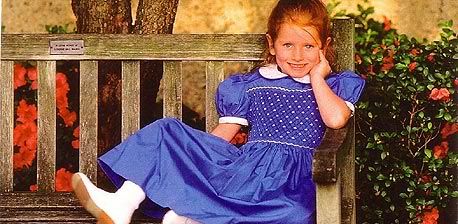
I still remember my favourite dress growing up. It was navy blue and smocked with pale blue tulips. I just adored it. I think my sister had a matching one in pale green.
Smocking is still a popular design feature in children's clothing, but most of it is pretty poor quality. Hand smocking is labour intensive, which makes it very expensive. But if you are looking for luxurious smocked outfits, look no further than Bois de Rose. Situated in the heart of Paris, Bois de Rose specializes in delicious smocked dresses (their website is in both French and English). I ran into this store two years ago while I was walking through the Latin Quarter with my mom. They were closed, but we peered through the window in astonishment. I had never seen such beautiful children's clothing (they have great things for both boys and girls and in an amazing variety of fabrics). They are truly little works of art. They are the Hermes of children's clothes! For the truly indulgent, Bois de Rose will even create matching dresses for your daughter and her doll! If you are ever in Paris, this shop is a must-see! I'm expecting the arrival of a neice in June, so this is one place I have to shop while I'm in Paris.
If you are drawn to the design appeal of smocking but want to avoid the hefty price tag, there is a smocking association, the Smocking Art Guild of America, and numerous websites that cater to smockers. If you want to learn to smock on your own, A-Z of Smocking is a comprehensive resource with easy to follow instructions and clear illustrations for all of the stitches(the company that publishes this book also publishes a smocking magazine in Australia--who knew smocking was popular enough to have its own magazine?).
In other news, only two more days until I leave for Paris! I'm so excited! But I'm also a little freaked out--I need to have my thesis all finished before I go. Right now I'm in the process of doing my last bits of editing and writing my abstract. I will be so glad to be done with this!
Posted by
Margaret
at
9:41 AM
2
comments
![]()
![]()
Labels: fashion, needlework, reviews
Monday, April 28, 2008
Spring Fashions Inspired by Art History
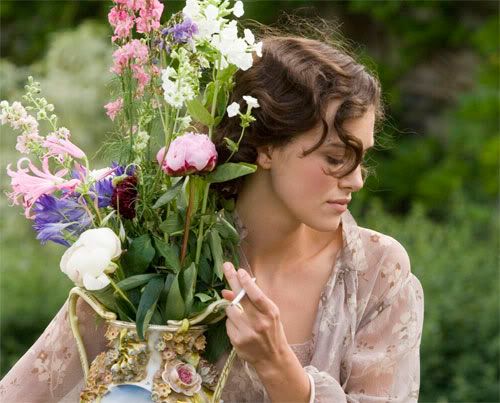
This spring's fashions are inspired by the kind of "romantic freshness" that was prominently displayed in last year's period drama, Atonement (starring Keira Knightly and James McAvoy).
The Spring runways almost always display the year's most feminine fashions, but this year they seem to have stepped it up a notch, with designs that borrow heavilly from the heady romanticism of the Pre-Raphaelites. And I'm not the only one who thinks so!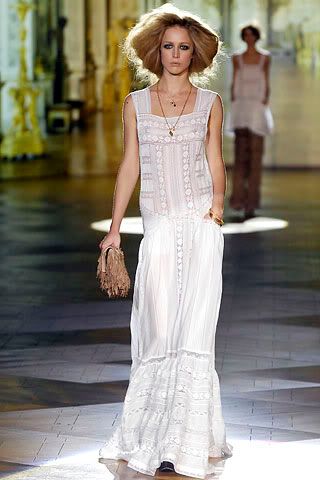 Horacio Silva just wrote a lovely piece for New York Times TMagazine on Jane Morris' contribution to this season's fashions, called The Innocence Project. Be sure and check it out! His discussion of the Pre-Raphaelite's influence on fashion is very interesting, although he does make a factual error (Jane Morris was not a fan of floral prints! Although she enjoyed using them for decorating, she preferred solids, which is amply evident in all of the photographs ever taken of her). The slide show of spring fashions accompanying the article really demonstrates the "turn to the romantic" that designers seem to be taking. Even Roberto Cavalli, who is best known for his plunging necklines and penchant for animal prints has shown a surprising romantic streak this season. This beautiful white lace gown is typical of the soft silhouette and feminine fabrics that Cavalli's utilizing this spring. Note also the Edwardian hairstyles! It looks like this will be a great season to find fearlessly feminine pieces in a variety of fabrics (especially soft floral prints).
Horacio Silva just wrote a lovely piece for New York Times TMagazine on Jane Morris' contribution to this season's fashions, called The Innocence Project. Be sure and check it out! His discussion of the Pre-Raphaelite's influence on fashion is very interesting, although he does make a factual error (Jane Morris was not a fan of floral prints! Although she enjoyed using them for decorating, she preferred solids, which is amply evident in all of the photographs ever taken of her). The slide show of spring fashions accompanying the article really demonstrates the "turn to the romantic" that designers seem to be taking. Even Roberto Cavalli, who is best known for his plunging necklines and penchant for animal prints has shown a surprising romantic streak this season. This beautiful white lace gown is typical of the soft silhouette and feminine fabrics that Cavalli's utilizing this spring. Note also the Edwardian hairstyles! It looks like this will be a great season to find fearlessly feminine pieces in a variety of fabrics (especially soft floral prints).
Posted by
Margaret
at
7:30 AM
6
comments
![]()
![]()
Labels: fashion, jane morris, pre-raphaelites
Tuesday, April 1, 2008
Jane Morris and Artistic Dress

Thomas Carlyle once wrote that "society is founded on clothes" and it seems that most social reformers throughout history have agreed. From the long hair sported by hippies in the swinging 60s to the indie fashions of today, clothing has always played a major role in protest. Not surprisingly, clothing also played a leading role in the Pre-Raphaelites vision for a better society. The fashion trend known as "artistic dress" which was popularized by the Pre-Raphaelite models was one of the movement's main legacies.
The movement towards artistic dress can be found in the Pre-Raphaelite's paintings and literature. In Morris' Utopian novel News from Nowhere, the working people are freed from the exploitation of greedy capitalists. One of the first things they do with their freedom is to create beautiful things, including clothing. Their dress is characterised by bright colours, embroidery and handcrafted buckles. The women of Nowhere are "clothed like women, not upholstered like arm-chairs"(53). Because their clothing is not as restrictive, the are able to participated in activities like rowing boats and making hay.
As with their notions about art and architecture, the Pre-Raphaelties weren't content to let their ideas about clothing remain in the art scene. Artistic dress soon became wildly popular in the real world as actresses and other women connected to the art world began imitating the styles sported by Jane Morris and the other Pre-Raphaelite models, such as Lizzie Siddal.
Artistic dress was a reform movement, and was sometimes referred to as "Dress Reform" or the "Rational Dress Movement." Dress reformers were particularly concerned with the restrictiveness of Victorian-era undergarments (especially the corset). As you can see from this painting of Jane Morris, her dresses did not have the extreme "wasp" or "S" shape that was all the rage at the time, and instead featured a more natural silhouette.
As the popularity of artistic dress grew, companies began offering styles that catered to the new trend. Arthur Lasenby Liberty's department store soon became a mecca for followers of the fashion of aesthetic or artistic dress. Liberty specialized in fabrics that appealed to fans of Pre-Raphaelite style and even sold ready-made "artistic" fashions.
Posted by
Margaret
at
8:38 AM
1 comments
![]()
![]()
Labels: fashion, jane morris, pre-raphaelites
Monday, March 31, 2008
Jane Morris and Pre Raphaelite Beauty
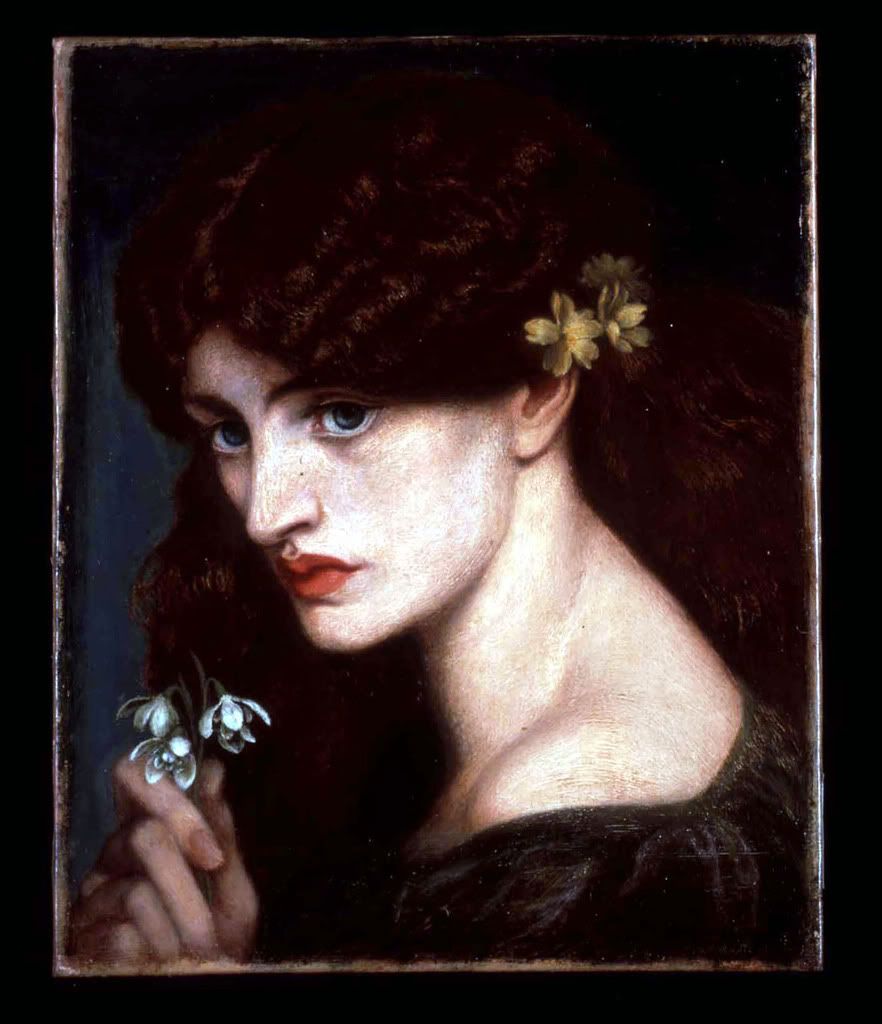
While the Pre-Raphaelite Brotherhood regarded Jane Morris as a "stunner" it took a while for the rest of the world to accept her unusual beauty. In a time where conventional standards of beauty were powerful and unbending, Jane's strong features challenged the norm. Many regard the Pre-Raphaelite models as the first supermodels. They were certainly among the first to popularize a long, lean silhouette in a time when extreme curvaceousness was in vogue.
Jane Morris was a celebrity in the art world, and stories of her rare beauty and delicate constitution seem to have spread like wildfire. When novelist Henry James came to visit the Morris family in 1869, he seems to have been particularly fascinated by Jane and commented extensively on her appearance:
"Imagine a tall lean woman in a long dress of some dead purple stuff, guiltless of hoops (or anything else, I should say), with a mass of crisp black hair heaped into great wavy projections on each side of her temples, a thin pale face, a pair of strange, sad, dark Swinburnian eyes, with great thick black oblique brows, joined in the middle and tucking themselves away under her hair, a mouth like the "Oriana" in our illustrated Tennyson, a long neck, without any collar, and in lieu thereof some dozen strings of outlandish beads"(61-62).
The praise reserved for Jane Morris is rather remarkable. After meeting Jane at Kelmscott House, Bruce Glasier, a Scottish socialist exclaimed:
"I had heard of her great beauty and had seen her portrait in some of the reproductions of Rossetti's pictures, but I confess I felt rather awed as she stood up tall before me, draped in a simple white gown which fell from her shoulders down to her feet. She looked like a veritable Astarte--a being, as I thought, who did not belong to our mortal world"(85).
Of course, Jane Morris' looks did not appeal to everyone, and many were highly critical of her strong features and artistic style of dress. And even fans of the style admitted that it was a welcome fashion trend for women who were not conventionally beautiful. Mary Eliza Haweis, a woman's rights activist, and author of The Art of Beauty and The Art of Dress, confessed that the Pre-Raphaelites were "the plain girl's best friends." She declared that
"Morris, Burne-Jones and others, have made certain types of face, once literally hated, actually the fashion...A pallid face with a protruding lip is highly esteemed. Green eyes, a squint, square eyebrows, whitey-brown complexions are not left out in the cold. In fact, the pink-cheeked dolls are no where; they are said to have "no character" and a pretty little hand is voted characterless too. Now is the time for plain women. Only dress after the Pre-Raphaelite style and you will be astonished to find that so far from being an "ugly duck" you are a full fledged swan"(88-89).
Jane Morris actually reminds me of Audrey Hepburn, in a way. At the time when Audrey Hepburn became a star, voluptuous women were the beauty standard and long, lean women like Hepburn were often regarded as rather plain. Audrey always argued that her look was very "attainable." She once said that "Women can look like Audrey Hepburn by flipping out their hair, buying the large sunglasses, and the little sleeveless dresses.”
Work cited: Debra N. Mancoff. Jane Morris: the Pre-Raphaelite Model of Beauty San Francisco: Pomegrantate, 2000..
Posted by
Margaret
at
9:47 AM
4
comments
![]()
![]()
Labels: fashion, jane morris
Wednesday, January 23, 2008
Redesigned Vintage Clothing
There are a lot of great articles all over the internet about how to recycle your used clothing. I see so many people on the streets every day that have found ingenious ways of recycling old tees (it was quite a trend a couple of years ago). Teens, in particular, really love the opportunity to take part in the design of their clothing. Overall, I think the popularity of companies like Preloved and others is a real sign of people's desire for new choices as consumers (and producers!). People seem to relish the innovation required in order to make use of vintage clothing items--and if they don't have time to do it themselve, many are choosing to purchase items from companies like Preloved. Jennifer Welch, owner of Virginia Wells, a San Francisco-based vintage clothing store, recently made the connection between her business and a growing Arts and Crafts movment in an interview with Green Living Online :
"In the late 19th century, the Arts and Crafts movement was a backlash against
the mass production that had come about after the Industrial Revolution. Today,
with increased technology and globalization, people want more integrity,
simplicity and utility - we yearn for grass-roots accessibility and to see
the individual instead of the advertising
campaign."
Posted by
Margaret
at
10:48 AM
1 comments
![]()
![]()
Labels: fashion, reviews, textiles, william morris
Saturday, January 5, 2008
The Pre-Raphaelite Obsession with Hair
One of the constant topics of discussion between myself and my husband is whether or not I should cut my hair. Although I love my long hair, I get an occassional yearning to chop it all off, a la Victoria Beckham (this usually happens after a long session of removing tangles). Last month in Vogue there was an article extolling the wonders of hair extensions, both permanent and clip-on. I can't help but compare my hair with the likes of Beyonce Knowles and Jennifer Lopez and wonder if I should just run out and get a weave.
While this sort of preoccupation with one's tresses might seem a bit excessive, it's nothing new. For centuries womankind have been doing all sorts of things to their hair in order to maximize their sex appeal, from the ancient Egyptians to the pouf-style wigs of Marie Antoinette.
During the Victorian period hair became an obsession.
I'm still debating getting a major haircut. I've gotten pretty attached to my locks, though I'm careful to maintain them as there's nothing I hate more than ratty hair. Really long hair always looks better in paintings, I think!
References: Jan Marsh, The Pre-Raphaelite Women: Images of Femininity in Pre-Raphaelite Art. London: Weidenfeld and Nicholson, 1987
Posted by
Margaret
at
1:01 PM
1 comments
![]()
![]()
Labels: fashion, pre-raphaelites
Friday, January 4, 2008
High-Button Shoes are Back in Fashion
Posted by
Margaret
at
12:44 PM
3
comments
![]()
![]()
Monday, December 10, 2007
Young Fogies
I found this site while surfing the net and it brought a smile to my face http://thegoodolddays.org/youngfogey.htm And I thought I was the only young fogey/luddite around! It's comforting to know that there are others out there. It seems that there's a growing movement out there!
Posted by
Margaret
at
12:52 PM
0
comments
![]()
![]()
Labels: fashion, philosophy

